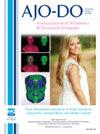叶黄素对正畸牙齿移动和复发的影响
IF 2.7
2区 医学
Q1 DENTISTRY, ORAL SURGERY & MEDICINE
American Journal of Orthodontics and Dentofacial Orthopedics
Pub Date : 2025-02-01
DOI:10.1016/j.ajodo.2024.09.011
引用次数: 0
摘要
简介叶黄素是一种天然类黄酮化合物,广泛存在于人类食物中。研究表明,木犀草素具有强大的抗炎特性,可影响炎症环境中的骨重塑。本研究旨在探讨叶黄素对正畸牙齿移动(OTM)和OTM后复发的影响:雄性 Sprague Dawley 大鼠随机分为 3 组(n = 8):方法:将雄性 Sprague Dawley 大鼠随机分为 3 组(n = 8):OTM 组、50 mg/kg/d 叶黄素组和 100 mg/kg/d 叶黄素组。然后,对所有动物施加 50 克正畸力。口服生理盐水或相应浓度的木犀草素。在 OTM 实验中,施力 14 天后处死大鼠,解剖上颌骨,然后进行显微计算机断层扫描、组织学染色和 Western 印迹分析。在复发实验中,取出弹簧,制作硅胶印模,记录复发情况:结果:与单纯 OTM 组相比,全身应用木犀草素可抑制 OTM 和牙齿复发(P 结论:木犀草素可显著抑制 OTM 和牙齿复发:叶黄素能明显抑制 OTM 和 OTM 后的复发。因此,在正畸治疗中,叶黄素是增强牙齿锚固和预防复发的一种前瞻性候选物质。本文章由计算机程序翻译,如有差异,请以英文原文为准。
The effects of luteolin on orthodontic tooth movement and relapse
Introduction
Luteolin is a natural flavonoid compound that widely exists in human food. Studies have demonstrated luteolin has powerful anti-inflammatory properties and can affect bone remodeling in an inflammatory environment. This study aimed to investigate the effect of luteolin on orthodontic tooth movement (OTM) and relapse after OTM.
Methods
Male Sprague Dawley rats were randomly divided into 3 groups (n = 8): OTM, 50 mg/kg/d luteolin, and 100 mg/kg/d luteolin. Then, 50 g of orthodontic force was applied to all animals. A saline solution or corresponding concentration of luteolin was given orally. For the OTM experiment, after 14 days of force application, rats were killed, the maxilla was dissected, and then microcomputed tomography, histologic staining, and western blotting were performed. For the relapse experiment, the spring was removed, and a silicone impression was made to record the relapse status.
Results
Compared with the OTM alone group, systemic administration of luteolin inhibited OTM and tooth relapse (P <0.05). Increased bone volume, reduced osteoclast activity, and a decrease in osteoclastogenesis-related protein expression were observed in luteolin-treated groups. These effects may be attributed to the inhibition of the nuclear factor-kappa B pathway.
Conclusions
Luteolin can significantly inhibit OTM and relapse after OTM. Thus, luteolin is a prospective candidate for enhancing tooth anchorage and preventing relapse in orthodontic treatment.
求助全文
通过发布文献求助,成功后即可免费获取论文全文。
去求助
来源期刊
CiteScore
4.80
自引率
13.30%
发文量
432
审稿时长
66 days
期刊介绍:
Published for more than 100 years, the American Journal of Orthodontics and Dentofacial Orthopedics remains the leading orthodontic resource. It is the official publication of the American Association of Orthodontists, its constituent societies, the American Board of Orthodontics, and the College of Diplomates of the American Board of Orthodontics. Each month its readers have access to original peer-reviewed articles that examine all phases of orthodontic treatment. Illustrated throughout, the publication includes tables, color photographs, and statistical data. Coverage includes successful diagnostic procedures, imaging techniques, bracket and archwire materials, extraction and impaction concerns, orthognathic surgery, TMJ disorders, removable appliances, and adult therapy.

 求助内容:
求助内容: 应助结果提醒方式:
应助结果提醒方式:


